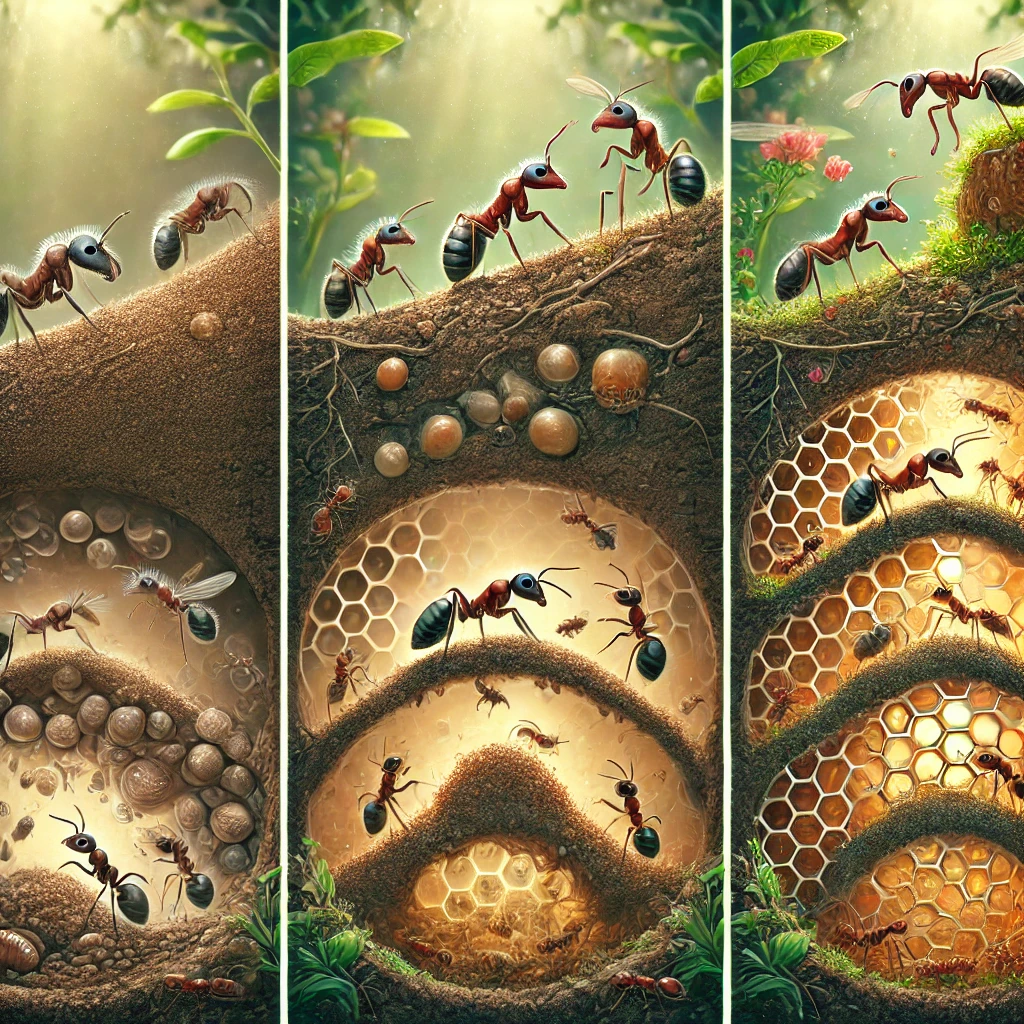Ant colonies are fascinating examples of social structure and organization in the animal kingdom. Each colony operates as a well-oiled machine, with different roles and responsibilities that contribute to the survival and expansion of the colony. Today, we’ll explore how an ant colony starts and evolves over time, from the solitary queen to a sprawling supercolony.
Stage One: The Queen’s Journey Begins
The journey of an ant colony begins with a single queen. After a nuptial flight, during which the queen mates with one or more males, she sheds her wings and searches for a suitable nesting site. This site is often a small hole or crevice where she can lay her first batch of eggs. The queen isolates herself in this initial chamber, sealing it off to protect herself and her eggs from predators and environmental hazards.
During this time, the queen relies on the energy reserves stored in her body to survive, as she will not leave the nest until her first brood of eggs matures. She lays a few eggs, which she meticulously cares for, ensuring they remain at the right temperature and humidity. This stage is crucial, as the success of these first eggs determines the future of the colony.
Stage Two: Emergence of the First Workers
After a period of incubation, the queen’s eggs hatch, and the first workers begin to emerge. These workers are the queen’s daughters, and their primary responsibility is to support the queen and expand the colony. Their initial tasks include foraging for food, maintaining the nest, and caring for the next batch of eggs that the queen will lay.
The emergence of the workers marks a significant milestone in the colony’s development. The queen can now focus solely on reproduction, while the workers handle all other necessary tasks. Foraging workers venture outside the nest to gather food, which they bring back to feed the queen, the larvae, and themselves. This division of labor allows the colony to grow rapidly, as the queen can lay more eggs, and the workers can provide the resources needed to support the growing population.
Stage Three: Rise of the Soldier Ants
As the colony continues to expand, a new type of ant begins to emerge: the soldier ants. These ants are larger and more robust than the workers, equipped with powerful mandibles designed for defense and hunting. Soldier ants play a critical role in protecting the colony from predators and rival ant colonies. They are also involved in hunting larger prey items, which provide valuable protein to support the growing number of larvae.
The presence of soldier ants enhances the colony’s ability to survive and thrive in a competitive environment. With soldiers guarding the nest and patrolling the territory, the workers can focus on their tasks without constant threat of attack. This division of labor further strengthens the colony’s social structure, ensuring that each member can perform their role effectively.
Stage Four: The Supercolony
Over time, the colony continues to grow and expand. Day by day, week by week, month by month, the number of ants increases, and the nest becomes more extensive. Some ant colonies can grow to immense sizes, with populations reaching into the millions and territory spanning several kilometers.
These supercolonies are marvels of organization and efficiency. They consist of numerous interconnected nests, with complex tunnel systems that allow ants to move freely between different parts of the colony. Supercolonies can dominate large areas, outcompeting other ant species and even altering the local ecosystem.
One famous example of a supercolony is the Argentine ant (Linepithema humile) supercolony in southern Europe, which stretches for more than 6,000 kilometers along the Mediterranean coast. This massive colony is composed of millions of individual ants from different nests that cooperate as a single entity.
The Lifecycle of an Ant Colony
The lifecycle of an ant colony is a continuous process of growth, division, and renewal. As the colony matures, it will eventually produce new queens and males, which will leave the nest to mate and start new colonies. This process, known as swarming, ensures the propagation of the species and the establishment of new colonies in different locations.
New queens will embark on their own journeys, shedding their wings and starting the cycle anew. Meanwhile, the original colony continues to thrive, with the queen laying eggs and the workers and soldiers maintaining the nest.
The Importance of Ant Colonies in Ecosystems
Ant colonies play vital roles in ecosystems around the world. They are involved in processes such as soil aeration, seed dispersal, and the decomposition of organic matter. Ants also form symbiotic relationships with various plants and other insects, contributing to the overall health and stability of their environments.
For example, leafcutter ants (genus Atta) are essential for nutrient cycling in tropical forests. They cut leaves and bring them back to their nests, where they use the plant material to cultivate fungus gardens. The ants feed on the fungus, and the decomposed plant material enriches the soil, promoting plant growth.
Conclusion
The development of an ant colony from a single queen to a sprawling supercolony is a remarkable journey of survival, cooperation, and adaptation. Each stage of the colony’s growth highlights the complexity and efficiency of these social insects, which have evolved to thrive in diverse environments worldwide.
Understanding the lifecycle and behavior of ant colonies not only provides insights into the natural world but also underscores the intricate relationships that sustain ecosystems. By studying these fascinating creatures, we can gain a deeper appreciation for the interconnectedness of life on Earth.
Thank you for reading, and I hope you enjoyed learning about the incredible world of ant colonies. Until next time, goodbye and see you in the next article!



